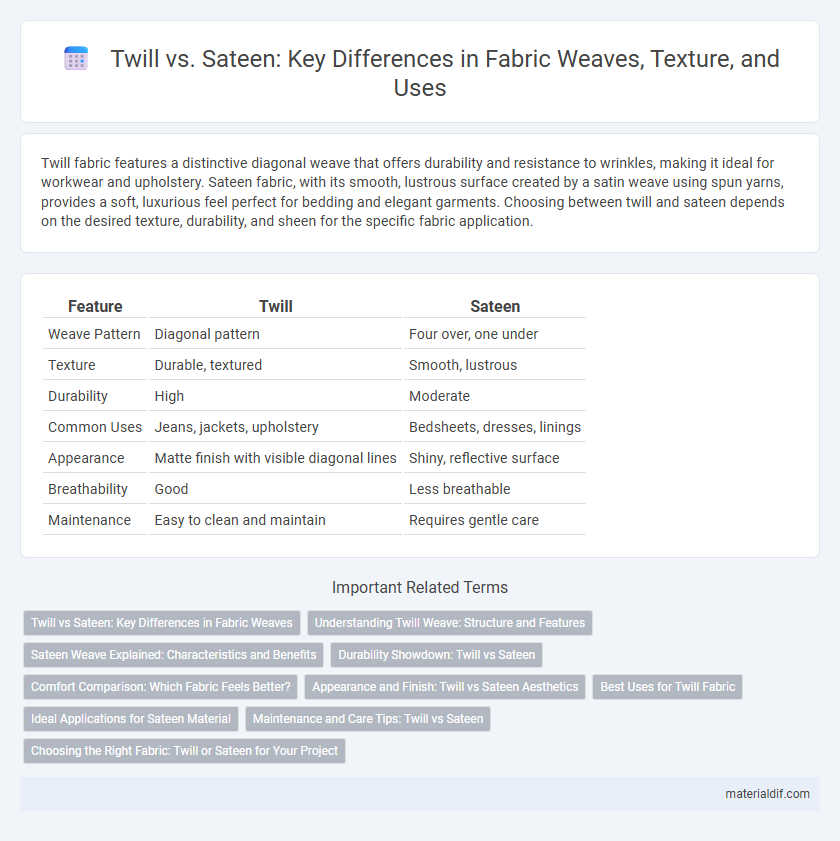Twill fabric features a distinctive diagonal weave that offers durability and resistance to wrinkles, making it ideal for workwear and upholstery. Sateen fabric, with its smooth, lustrous surface created by a satin weave using spun yarns, provides a soft, luxurious feel perfect for bedding and elegant garments. Choosing between twill and sateen depends on the desired texture, durability, and sheen for the specific fabric application.
Table of Comparison
| Feature | Twill | Sateen |
|---|---|---|
| Weave Pattern | Diagonal pattern | Four over, one under |
| Texture | Durable, textured | Smooth, lustrous |
| Durability | High | Moderate |
| Common Uses | Jeans, jackets, upholstery | Bedsheets, dresses, linings |
| Appearance | Matte finish with visible diagonal lines | Shiny, reflective surface |
| Breathability | Good | Less breathable |
| Maintenance | Easy to clean and maintain | Requires gentle care |
Twill vs Sateen: Key Differences in Fabric Weaves
Twill and sateen are two distinct fabric weaves characterized by their unique patterns and textures; twill features a diagonal rib pattern that enhances durability and hides stains, commonly used in denim and chinos. Sateen weave creates a smooth, lustrous surface with a subtle sheen by floating warp yarns over weft yarns, providing a softer hand suitable for luxurious bedding and apparel. The key differences lie in twill's robust, textured appearance versus sateen's glossy, silky finish, impacting both visual appeal and fabric performance.
Understanding Twill Weave: Structure and Features
Twill weave is characterized by its diagonal rib pattern created through a specific weaving technique where the weft thread passes over one or more warp threads and then under two or more warp threads. This structure provides twill fabrics with greater durability, flexibility, and resistance to wrinkles compared to plain weaves, making it ideal for garments like denim and chinos. The distinctive diagonal lines enhance texture and drape, offering both aesthetic appeal and functional strength.
Sateen Weave Explained: Characteristics and Benefits
Sateen weave features a four-over, one-under pattern, creating a smooth, lustrous surface with a subtle sheen, making it ideal for luxurious bedding and apparel. This weave structure produces a softer, more pliable fabric that resists wrinkles and drapes beautifully while maintaining durability. Its smooth texture and natural sheen enhance comfort and aesthetic appeal, offering a sophisticated alternative to traditional cotton weaves like twill.
Durability Showdown: Twill vs Sateen
Twill fabric boasts superior durability due to its tightly woven diagonal pattern, which resists wear and tear better than flimsier weaves. Sateen, with its smooth, glossy surface created by floating yarns, tends to be less resilient and more prone to snagging and abrasion. For long-lasting performance in upholstery or heavy-use garments, twill remains the more durable choice compared to sateen.
Comfort Comparison: Which Fabric Feels Better?
Twill fabric offers a soft yet durable texture with a diagonal weave that enhances breathability, making it comfortable for long-term wear. Sateen, characterized by a smooth, glossy surface due to its satin weave, feels luxuriously silky against the skin but may trap heat more than twill. Choosing between twill and sateen depends on preferences for breathability versus a sleek, smooth finish.
Appearance and Finish: Twill vs Sateen Aesthetics
Twill fabric features a distinctive diagonal rib pattern that creates a textured and durable surface, offering a matte finish with subtle sheen. Sateen, made by weaving with a satin weave structure, has a smooth, lustrous surface and a glossy sheen that reflects light elegantly. The appearance of twill is more casual and rugged, while sateen provides a sleek, polished look often associated with luxury bedding and apparel.
Best Uses for Twill Fabric
Twill fabric, known for its distinctive diagonal weave, is ideal for durable clothing such as jeans, workwear, and uniforms due to its strength and resistance to wrinkles. Its textured surface enhances both appearance and durability, making it a popular choice for upholstery and heavy-duty drapery. Comfort and longevity in everyday fabrics position twill as the preferred option for garments requiring resilience and ease of maintenance.
Ideal Applications for Sateen Material
Sateen fabric, characterized by its smooth, lustrous surface created through a satin weave, is ideal for applications requiring a soft and luxurious feel, such as high-quality bed linens, elegant drapery, and comfortable apparel like blouses and dresses. Its slight sheen and silky texture make it popular in home textiles where aesthetic appeal and comfort are essential. Sateen's durability combined with its smooth finish also suits upscale upholstery and decorative cushions, enhancing both visual appeal and tactile comfort.
Maintenance and Care Tips: Twill vs Sateen
Twill fabric, known for its diagonal weave, requires gentle machine washing with cold water to maintain its durability and avoid fabric distortion. Sateen, characterized by its smooth, lustrous surface, benefits from delicate hand washing or a gentle machine cycle with mild detergent to preserve its sheen and prevent pilling. Both fabrics should be air-dried and ironed on low heat to extend fabric life and keep appearance intact.
Choosing the Right Fabric: Twill or Sateen for Your Project
Twill fabric, known for its distinctive diagonal weave, offers durability and resistance to wrinkles, making it ideal for garments and upholstery requiring strength and texture. Sateen fabric, characterized by its smooth, lustrous surface from a satin weave, provides a luxurious feel and subtle sheen, perfect for bedding and elegant clothing. Selecting between twill and sateen depends on the project's need for durability versus softness and visual appeal, with twill excelling in heaviness and structure while sateen emphasizes smoothness and drape.
Twill vs Sateen Infographic

 materialdif.com
materialdif.com